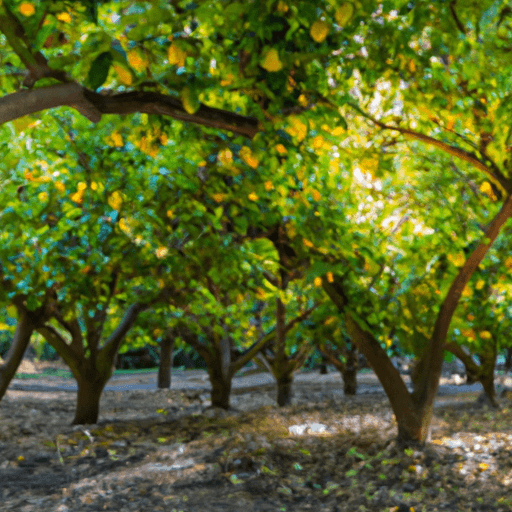Peanut butter trees, scientifically known as Arachis hypogaea, are fascinating plants that require specific care to thrive. With their preference for full sun and well-drained soil, these trees can add a unique touch to any garden.
Their drought tolerance and ability to withstand temperatures as low as -10 to -15 degrees Fahrenheit make them a hardy choice for many climates.
In this article, we will explore the ideal growing conditions, planting and watering tips, pruning and shaping techniques, propagation and container growing methods, as well as overwintering and pest control strategies for these remarkable trees.
Ideal Growing Conditions
Peanut butter trees, scientifically known as Arachis hypogaea, thrive in full sun but can benefit from some afternoon shade in hotter areas. This shade helps protect the trees from excessive heat and sun exposure, preventing sunburn and dehydration.
To ensure optimal blooming, fertilizing is crucial. A horticulturist or botanist would recommend using a water-soluble fertilizer high in phosphorus during spring. This nutrient promotes blooming and enhances the overall growth of the tree.
Additionally, these experts would emphasize the importance of research-based information when discussing the cultivation and care of peanut butter trees. They would rely on scientific studies and reputable sources to support their recommendations, avoiding unfounded claims or personal opinions.
Planting and Watering Tips
Watering regularly and ensuring proper drainage is crucial for the healthy growth of peanut butter trees. These trees benefit from some afternoon shade in hotter areas, as it helps protect them from excessive heat and sunburn.
It is important to provide adequate water to peanut butter trees, as they require consistent moisture to thrive. Improper watering can lead to stress, yellowing leaves, and even plant death. To ensure proper watering, horticulturists recommend checking the soil moisture regularly and watering deeply when necessary.
Additionally, providing a layer of mulch around the base of the tree helps retain moisture and regulate soil temperature. Proper watering, along with the benefits of afternoon shade, creates optimal growing conditions for peanut butter trees, promoting healthy growth and abundant harvests.
Pruning and Shaping Techniques
To maintain the desired shape and size of the tree, gardeners can prune peanut butter trees by removing suckers and dead or damaged growth. Pruning techniques and shaping methods are essential for promoting healthy growth and maintaining the desired form of the tree. By carefully pruning young shoots and removing suckers, gardeners can control the plant’s aggressive growth and shape it into a tree form. Pruning dead or damaged growth in the spring before blossoms form helps maintain the overall health of the tree. It is important to prune suckers by cutting them as close to the base as possible to prevent regrowth. By following proper pruning techniques, gardeners can ensure that peanut butter trees remain healthy and visually appealing.
| Pruning Techniques | Shaping Methods |
|---|---|
| Remove suckers and dead or damaged growth | Prune young shoots to maintain shape |
| Cut suckers close to the base | Shape the tree into a tree form |
Incorporating these pruning techniques and shaping methods will help gardeners successfully care for their peanut butter trees.
Propagation and Container Growing
Propagation of peanut butter trees can be achieved through semi-hardwood cuttings. These cuttings are dipped in rooting hormone and planted in well-drained soil. This technique allows for the creation of new peanut butter tree plants from existing ones.
The process begins by carefully selecting a healthy branch with semi-hardwood growth. The branch is then cut to a length of about 6 inches and any leaves or stems are removed. The cut end of the cutting is treated with rooting hormone to stimulate root development.
Once treated, the cutting is planted in a well-drained soil mixture. It’s important to keep the soil moist but not overly wet. With proper care and attention, these cuttings will develop roots and can be transplanted into larger containers or directly into the garden.
When selecting containers for peanut butter tree cultivation, it’s important to choose ones that provide adequate drainage and room for root development. This helps ensure healthy growth and prevents waterlogged soil conditions that can lead to root rot.
Overwintering and Pest Control Strategies
Frost-sensitive, peanut butter trees require special care during the winter months to prevent damage. This includes overwintering in a greenhouse or warm area and using burlap for protection. Horticulturists and botanists recommend these strategies to protect peanut butter trees from frost.
It is important to provide the trees with a suitable environment to ensure their survival. This includes ensuring they are planted in well-drained soil and receiving the appropriate amount of sunlight.
Peanut butter trees are also susceptible to pests such as aphids and whiteflies. To control these pests, horticulturists suggest using insecticidal soap. Additionally, fungal diseases like leaf spot can be treated by pruning dead leaves and applying fungicide.
When discussing the care of peanut butter trees, it is crucial to rely on research-based information and provide detailed observations based on expertise and experience.







